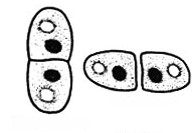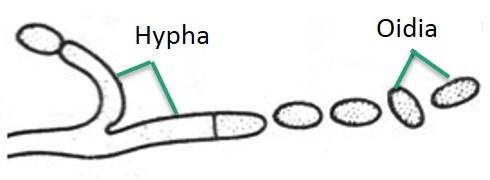Fungi - Vegetative Reproduction
Description:
Vegetative reproduction can occur by fragmentation, budding, fission, sclerotia and rhizomorphs.
Sclerotia are penetrating bodies made up of compact masses of hyphae. They grow under unfavourable conditions to produce new mycelia.
Rhizomorphs are rope like twisted masses of hyphae with well defined apical growing point. Pass the unfavourable periods in dormant stages but with the onset of favourable conditions each rhizomorph give rise to a new mycelium.
Vegetative reproduction can occur in various ways −
Fragmentation − Hyphae breaks into pieces and each piece give rise to a new mycelium.

Fission − Common in yeast. Cells divide into daughter cells.

Budding − Daughter buds appears from parent cell. This bud separates and forms a new organism. At times these buds fail to separate and after repeated budding it forms pseudomycelium.

Oidia − Round or oval structures having thin walls. Produce yeast like called oidia. Each oidium on germination produces new mycelium.

Chlamydospores − Thick walled resting spores produced by some fungi. They are capable of forming new organisms on approach of favourable conditions.

Gemmae − They represent chlamydospores in structure but are not very durable and thick walled.

